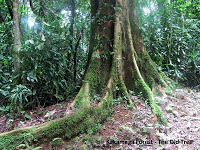The only tropical rainforest in Kenya and the last remnant of the great rainforest that once stretched across all of Central Africa, the Kakamega National Reserve is a very special treat. Just imagining what the great swath of rainforest across the continent must have been like is truly a mind-boggling exercise, and it’s nice to think that one can get an idea of all that natural beauty and the eco-structure by wandering about in the Kakamega Forest.
Of course one doesn’t just wander about. It’s important to have a good guide (which we had) because there’s just too much to see and observe. And to learn, if one isn’t a naturalist by profession or inclination, for I was constantly hearing new terms and concepts and seeing things that I would never have thought to look for.
There’s also another good reason to have a qualified guide along with you: Twenty-seven species of snakes live in the forest, most having slithered there over the ages from West Africa, emphasizing again the cross-continental nature of the reserve. We didn’t actually “see” any snakes, but we were often told by the guide to avoid stepping in this or that spot. We were well protected, with safari boots and heavy socks and long trousers but still….
So for those who are curious about these things (I’m not, as I’m subject to bad dreams if I think too much about snakes), the snakes of Kakamega Forest include the Forest Cobra, the Black-lipped Cobra, Jameson’s Mamba, the Bush Viper, the Rhinoceros-horned Viper (which I particularly did not want to encounter!), the Gaboon (or Gabon – it’s spelled both ways) Viper, and the Gold’s Cobra.
Monkeys again. The place is full of the Black and White Colobus Monkeys (like the ones we saw at Lake Naivasha), the De Brazza’s Monkey, the Red-Tailed Monkey, and of course the ubiquitous baboons. Wonderful primates, and they give a whole new meaning to a visit to Kakamega. They were all over your head, and as you look up into the very far-away treetops, you can see them jumping from branch to branch, appearing to be watching the other primates down below.
Many, many birds, far too many for me to keep track of, but some beautiful species I had never seen before. After the time spent watching the bird watcheres in Hell’s Gate and now in Kakamega (and observing the seeming innumerable birds in the collection at the Nairobi National Museum, perhaps the subject of another posting sometime in the future), one could be tempted to try to learn more about bird-watching.
Perhaps the most spectacular things one sees at Kakamega Forest are the “oldest tree” (pictured above) and the fantastic view from the top. This giant Elgon olive tree (which they say is the home to the “exceedingly rare” De Brazza’s monkey, which we did not see, sadly) is an amazing site, and, if it really is an olive tree, so different what we’ve come to know as olive trees that it is almost too hard to believe.
From the top, the view is amazing. First of all, you’re very high up, about 1500 to 1700 meters above sea level (that’s about 4900 to 5600 feet, I guess) and the distances you can see are a little overwhelming. The place is pretty big (about 44 square kilometers, or about 17 square miles), and as you can see in the PHOTOGRAPHS, we had a beautiful day for our visit to Kakamega. One of the mountains we could see in the distance was some 45 miles away, so the experience was, indeed, pretty awesome.
Back down on the earth, and after a very long drive and an even longer walk, we got to the Isiukhu Falls, a beautiful site and one much appreciated at this particular time of the year, the long rainy season when the water is at its “fullest” and the foamy spilling over the rocks is a very special site. We were absolutely alone (which we were for most of the day) and the quietness of the place, broken only by the splendid noise of the rushing water, made this a very special experience.
Indeed, the quietness of the entire day was very enjoyable, but also a little sad. This safari had taken me far away from the metropolitan Nairobi area, and since the difficulties of the political upheavals and the riots following the election of 2007 and the general overall global financial crisis, tourists coming to Kenya are coming to the most popular and easy-to-get-to parts of the country, and the beauties of Western Kenya are being pretty much ignored by the visitors. It’s too bad, and while the peacefulness of being practically alone as one travels is rewarding in a different kind of way, it’s sad to see so much of the economy being reduced by the lack of tourists.

Leave a Reply